Hanover Bald Eagle Blog # 19 - 2021
In partnership with Comcast Business and Pennsylvania Game Commission .
Over the past few weeks, the Hanover eaglet has appeared more and more curious about their surroundings. They peer intently at sticks, toy with nest substrate, and look down over the edge of the nest with rapt attention. This increase in attentiveness is normal for bald eagles at this stage of development and provides endless entertainment for those of us watching from home.
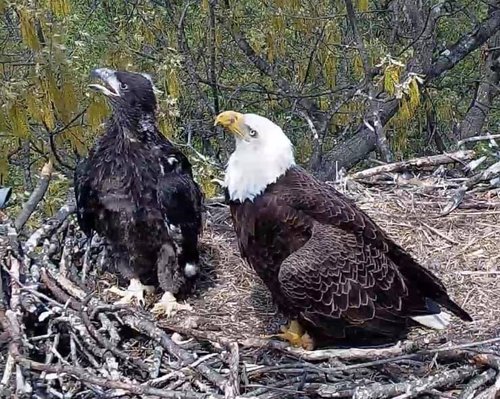
Several behaviors indicate that an eaglet is in this curiosity stage, such as beating of the wings, frequent preening, stabbing at sticks and testing or mimicking parents. Bald eagles fledge (leave the nest) between 8 and 14 weeks (about 3 months) after hatching. Today is the Hanover eaglet’s 8th week of life (58th day) since hatching. This explains why we have seen the eaglet beating their wings and preening so often: strengthening flight muscles and maintaining feathers are important precursors to taking first flight.
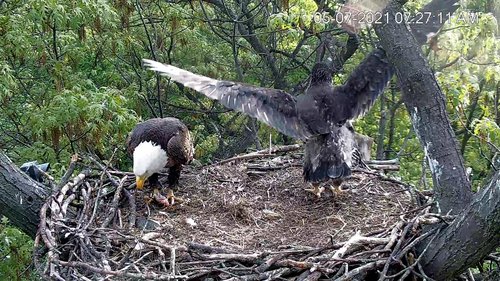
Bald eagles, being large scavenging raptors, undergo a longer developmental stage than smaller raptors like falcons and many hawks. Eagles spend a relatively long time in the nest and a long time learning from other eagles after they fledge (leave the nest). Research shows that after fledging, eaglets continue interacting with their parents for up to 10 weeks. Parents continue to bring food to their young and lead them to foraging sites such as carcasses (whether intentionally or not). After about six weeks, eaglets begin hunting on their own.
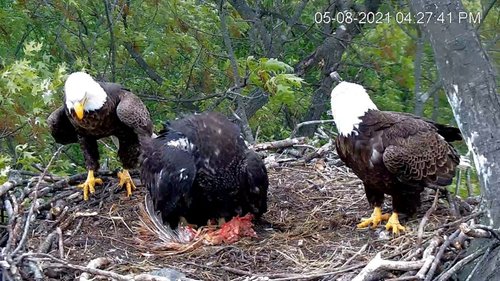
In preparation for their first flight and life outside the nest, nestling bald eagles become increasingly exploratory in the later stages of the nesting period. In their bookThe Bald Eagle, Haunts and Habits of a Wilderness Monarch, Gary Bortolotti and Jon M. Gerrard describe an amusing event during which two eaglets seemed startled and perplexed by a fish delivered to the nest. The fish was still moving. One eaglet crept forward and barely touched the fish, which then flipped over, causing both eaglets to jump back in unison. This happened several times, ending with the fish finally flapping itself out of the nest and landing on the forest floor below. Both eaglets hopped to the edge of the nest and peered over. This example serves as a reminder that humans are not the only ones who undergo a “toddler” stage, and that trial and error is an important part of the learning process for eaglets. We can all relate to the payoff of learning from our mistakes and for a young scavenger, those “aha moments” are especially important.
Evidence shows that an eaglet’s formative experience during the nestling and post-fledging stage impacts their behavior later in life, especially when it comes to hunting and foraging. In his book Raptors: The Curious Nature of Diurnal Birds of Prey, Keith Bildstein explains it this way: “Observations suggest that early experience plays a key role in establishing individual differences in prey selection within species of diurnal birds of prey. As a result, the diets of widespread, feeding generalists can vary both geographically and seasonally” (p. 79). Here, the term diurnal means active during the day.
Bald eagles specialize in catching and eating fish; however, they are also generalists, meaning they scavenge on whatever they can find. Eagles in Missouri, for example, hang out around waterfowl overwintering grounds. Eagles in Alaska and the Pacific Northwest visit shallow gravel bars where salmon die after making their way back to spawning grounds. In the San Juan Islands, bald eagles congregate when seal pups are born, feeding on those that do not make it.
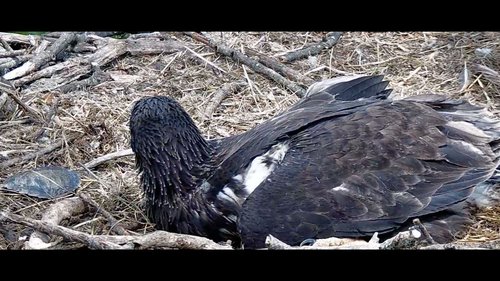
A turtle shell seen in the Hanover nest, likely brought in over the weekend.
Taking advantage of such feeding opportunities requires learning and a willingness to try new things, two common characteristics of scavengers. Bald eagles are also relatively social and are therefore constantly learning from each other, whether it be at a communal roost, from their parents and siblings, or on scavenging grounds where large numbers of birds congregate.
Oftentimes nestling bald eagles learn alongside their sibling. This year, in the absence of a sibling, the Hanover eaglet is likely watching mom and dad closely for clues on how to be an eagle, and this is where some of the mimicking behavior we have observed may come into play. Once the eaglet fledges, they will remain close to the parents not only for food, but also to continue observing and picking up new lessons.
The Hanover eaglet will eventually reach a point at which the benefit of sticking to what they know will outweigh the energy required to experiment with new techniques. Although we may not be able to follow the Hanover eaglet once they leave the nest, we can trust that the adults will teach this little one everything they need to know. Collectively, the Hanover family carries a great deal of knowledge that can only be earned by watching, learning, and doing. As we soak up the remaining weeks of nest cam observation, we will likely see the Hanover eaglet preparing for flight and peering inquisitively over the edge, soaking up observations of their own.
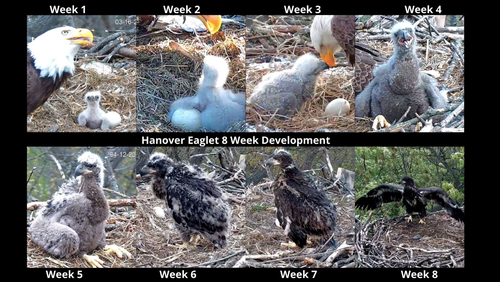
Sources
Bildstein, Keith L. (2017). Raptors: The Curious Nature of Diurnal Birds of Prey. Cornell University Press.
Buehler, D. A. (2020). Bald Eagle (Haliaeetus leucocephalus), version 1.0. In Birds of the World (A. F. Poole and F. B. Gill, Editors). Cornell Lab of Ornithology, Ithaca, NY, USA. https://doi.org/10.2173/bow.baleag.01
Griffin, C., & Baskett, T. (1985). Food Availability and Winter Range Sizes of Immature and Adult Bald Eagles. The Journal of Wildlife Management, 49(3), 592-594. doi:10.2307/3801677
Newton, Ian. (1979). Population Ecology of Raptors. T & A D Poyser Ltd.
ATTENTION HANOVER EAGLE VIEWERS - We recognize that over the years this bald eagle pair has been named by the public and is commonly referred to as "Freedom" and "Liberty". While we understand that naming the eagles helps connect and distinguish the female from the male eagle, naming the pair introduces an element of domesticity to wild animals. In order to respect the eagles and focus on their natural history, we will refer to the female and male as such as per recommendations of the Pennsylvania Game Commission.
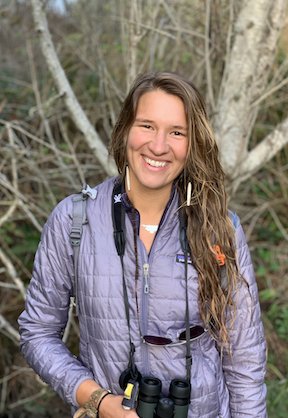
RAPTOR ECOLOGY SPECIALIST - ZOEY GREENBERG
RETURN TO HANOVER BALD EAGLE BLOGS
WATCH THE HANOVER BALD EAGLE LIVE CAMS
For over 20 years, HDOnTap has provided live streaming solutions to resorts, amusement parks, wildlife refuges and more. In addition to maintaining a network of over 400 live webcams, HDOnTap specializes in design and installation of remote, off-grid and otherwise challenging live streaming solutions. Contact press@hdontap.com for all media needs, including images and recordings.